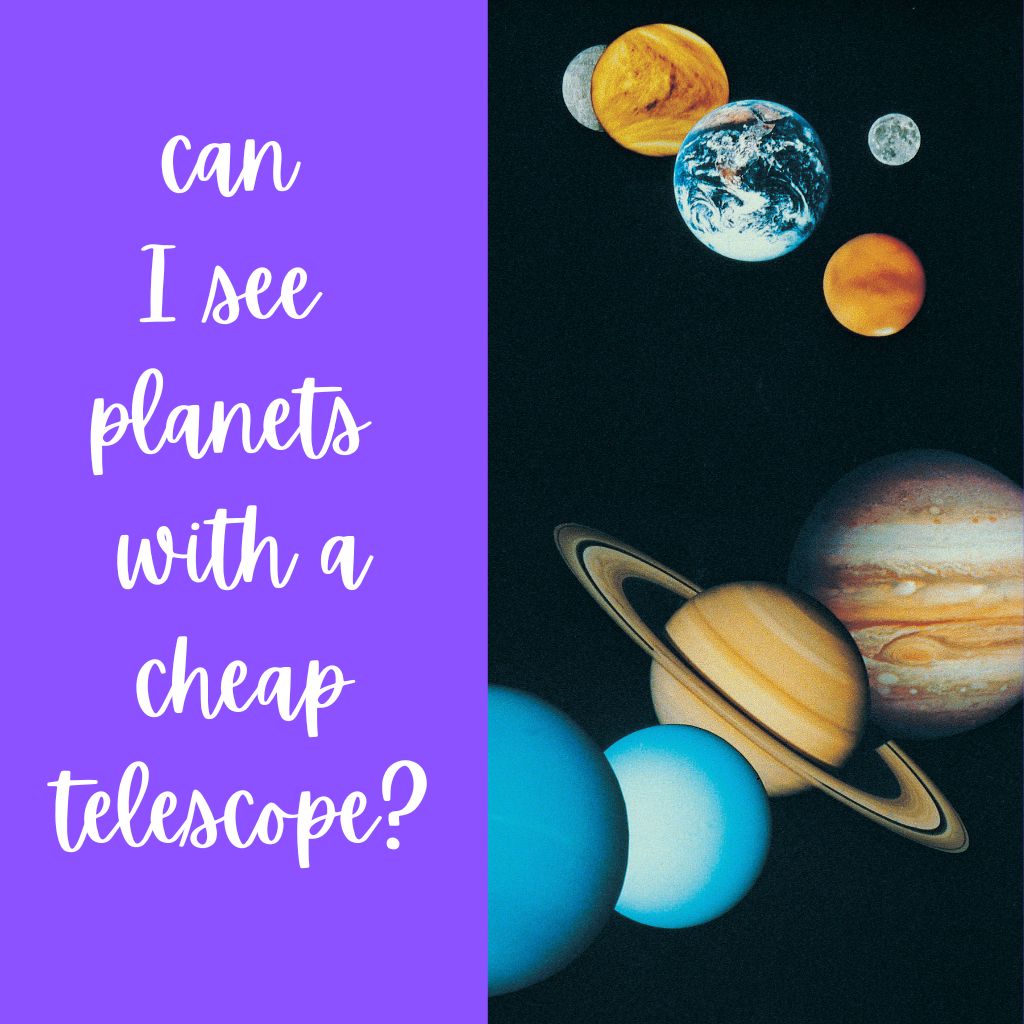This site contains affiliate links to products. I may receive a commission for purchases made through these links.
You can view planets with a cheap telescope. The image quality may not be great, but you can enhance it with filters. Plus, you get a decent magnification. Also, it usually takes more work to focus these telescopes because you don’t get a motorized mount. However, if you can iron out these little quirks, it’s a solid deal for usually around $100.
In this article, we will tell you about the best cheap telescopes on the market. We will tell you their drawbacks. And we will also give you some tips on improving your observations.
Planets visible with a cheap telescope
You can view almost all the planets in our solar system using a cheap telescope. These are easy to spot in the night sky with less light pollution.
Mercury
You can view Mercury with a cheap telescope. The optimal time to look at Mercury is when the planet is at one of its elongations. That’s when it’s farthest to the west relative to the Sun when seen from an Eastern morning sky.
Usually, the best time to view Mercury is midday.
Once you locate it, use a yellow or orange filter. This will help you reduce the sky’s blue light and help produce a sharp picture. If you want to see details, you might need a lens with a long focal length to view them.
Venus
Venus shines brighter than Mercury and is far easier to observe than Mercury. Planetary observation is very easy, especially when the planet moves slowly between the Earth and the Sun.
Since Venus is closer to us during that phase, we can see the planet’s size and phases change with time. It’s much easier to observe during the daytime.
Several features can be visible in Venus’s atmosphere. These include dusty shadings and even some bright cloud features. You would need a violet filter to see the most famous among them, specifically #47.
With the filter installed on an 8-inch telescope, you must look for a C- or a Y-shaped feature centered around the planet’s equator.
Mars
Observing the Red Planet is easy, especially at high magnification. You can study the planet’s surface if the atmosphere holds steady. It’s best to keep your focus centered on a small area.
The planet looks great if you use a blue or violet filter. The specific codes are #80A and #47. But if you want to view something closer to the surface, use a green filter. This is the #58 one.
You get to observe a lot of different things. These include the morning and evening clouds. The surface fog appears before the martian sunrise clears it away.
During the evening, the clouds tend to be more massive and greater in number. Using a blue or violet filter to sharpen bright cloud features as you view them is best.
You may also like: What Telescope Size Do I Need to See Mars?
Jupiter
After the Sun, the planet Jupiter is the biggest celestial object in our solar system. And it also happens to be the celestial object with the most observable detail.
You can see a lot of different features. These include dark stripes formed by the North and South Equatorial Belts. These stripes flank Jupiter’s equator on either side.
Watching it in the night sky is also really fun. You can see Jupiter’s moons change positions. And the best part is that the planet’s rotation brings all of this into your view within a single night. How crazy is that?
Jupiter’s moons are one of its most salient features. And, of course, there’s the Great Red Spot!
You will likely need a dark blue filter to help you see the planet’s zones better. This is a #38A filter. These blue filters help sharpen bright cloud features.
If you use a red filter, like #23A, you can see more details across the equator. It will also help in improving the contrast of the major belts.
You may also like: 11 Best Telescopes to See Jupiter.
Saturn
Saturn is a little further away, so you need an 8-inch telescope. It would be best if you tried to observe the Cassini Division. This is a dark gap that occurs between Saturn’s two brightest rings.
Also, try to notice how the bright or dark spots compared to the zones around them from the night before. These tend to change in position from one night to the next.
Saturn’s zones have a yellowish color. They can appear greyish, yellowish, or even have a tinge of off-white.
You will need some filters to view the bright spots like they are meant to be seen. These include the #58 and the #56 filter. These are the green and light green filters, respectively.
Also, add a #82A filter that helps to improve the contrast of light blue features.
Read also: How Big of a Telescope Do You Need to See Saturn’s Rings?
Uranus and Neptune
Uranus’s atmosphere often tends to appear featureless and hazy. The first details of the planet’s atmospheric features came out in 1870. Since then, we have observed several dark stripes and other markings.
The greenish Uranus appears to be a slightly elliptical disk. And that’s because of its very fast rotation. However, the movement around the axis is slow. It takes almost 44 days to move the same distance as the diameter of a full moon.
Neptune is much easier to find. When viewed through a small telescope or binoculars, it appears to be a small blue disk.
However, even a large telescope only adds a little detail to the view because it’s just that far away. But you will be able to see one of its largest moons, Triton.
Best cheap telescopes for planet observation
The telescopes in this section are going to be cheap. That means they might not compare to top-tier compound telescopes used for astrophotography.
However, these telescopes do a good job of visualizing the planets in the night sky. So, let’s take a look at
Celestron PowerSeeker 127EQ
With the Celestron PowerSeeker, you pack quite a punch for just a few dollars.
Aside from the telescope, you get two eyepieces: a 20 mm erect-image eyepiece and a 4 mm eyepiece. You also get a 3x Barlow lens and a Star Pointer finderscope. The latter comes in handy when trying to locate Mercury, for instance. You also get a height-adjustable tripod and a counterweight.
The telescope is easy to set up without using any tools, and you can quickly get it up and running.
The mount is a German equatorial mount, which means it’s sturdy. And it comes with slow-motion manual controls that can help you smoothly track the objects across the night sky.
And the best part is that you get high-quality, coated optical elements. This means your image quality gets greatly enhanced with better clarity and brightness.
How cool is that?
Orion SkyScanner 100mm
The Orion SkyScanner is priced even lower than the Celestron PowerSeeker.
This is the ideal entry-level telescope for beginners. It has a quick, easy operation. And it’s very portable with grab-and-go capabilities.
The primary lens of this telescope is 3.9 inches in size. That means it’s great for visualizing bright deep-sky objects. You can even see the planets with it when they are close, especially the Red Planet. But you might not be able to see a lot of detail.
However, beautiful star clusters and nebulae would be fine. And you can even see the craters on the moon.
Its mount has a swivel base. This means you can easily maneuver the telescope wherever you want.
The package includes two eyepieces: a 20mm and a 10 mm. You also get the EZ Finder II, which will help locate different deep-sky objects when you want to see the planets. You will get a MoonMap and a glare-reducing filter that helps you see the moon.
Meade Instruments Infinity 102mm
The next item on the list is the Meade Instruments Infinity. With this telescope, you get a good focal length. This means a high magnification. Coupled with the slightly bigger 4-inch aperture, it can produce stunning images.
The telescope comes with slow-motion controls. These help you steadily pan the telescope across the sky to track different objects. You can use it for daytime viewing or to see the planets in the evening sky.
You get three different eyepieces with this telescope: 26 mm, 9mm, and 6.3 mm. And you also get a 2x Barlow lens which can further increase the magnification of each eyepiece.
In addition to all that, you also get a red dot viewfinder. This finderscope will greatly enhance your planet-locating skills. That’s especially hard when you want to see the planets with all the city lights polluting your view.
And you even get a fun instructional DVD. Who doesn’t love some old-school exclusive educational content?
Celestron 70mm Travel Scope
With the Celestron 70mm Travel Scope, you get full-coated optic elements. That means your picture quality is going to get enhanced. You will also get sharp, crisp images.
This telescope has an aperture of a little over 2.76 inches. While that could be better, it still makes a decent telescope.
You also get a tripod and two eyepieces. There’s a 20mm eyepiece and a 10mm eyepiece. With these, you can view celestial objects at night. And because it’s a travel scope, you also have a backpack to carry wherever you go.
If all of that wasn’t enough to convince you that it’s a good telescope, you also get a 2-year warranty from the seller if you purchase it on Amazon.
You may also like: What Can You See With a 70mm Telescope?
Zhumell Z114 Portable Altazimuth Reflector Telescope
This is another cheap telescope. The Zhumell Z114 is comparable to some of the telescopes on the list. It has a 4.5-inch aperture, which isn’t too small to see faint objects. However, it’s not too big to reveal a lot of details.
This means that it’s in its league of intermediate telescopes. It’s better than the cheapest telescopes but not as good as the more expensive ones.
The highest magnification you can get with it is 224x. You receive two eyepieces with the telescope: 17mm and 10mm. And you get a focal length of 456 mm, which is good.
Completely assembled, this telescope weighs a little over 11 lbs, which makes it very easy to carry.
You get a red dot finder that can help you locate planets and a Dobsonian base. The latter allows you to track different objects across the night sky smoothly.
While spending money on an intermediate telescope is probably not the best idea, it will outperform others on the list.
Therefore, if you want a better image quality than you would get with a $150 telescope, we suggest you buy Zhumell Z114.
Limitations of a cheap telescope in planetary viewing
When buying the cheapest telescopes, you have to understand that they won’t be able to compete with their more expensive counterparts. There are several obvious drawbacks to buying a cheap telescope.
Let’s discuss them.
Small aperture size
A small telescope offers a small aperture size. This means you won’t be able to see the planets very clearly. Therefore, you won’t be able to notice the details on their surface or study them using astrophotography.
Limited magnification range
Small telescopes often have a small focal length. This means they can’t magnify the planets for you the way you want them to be magnified.
Lack of accessories
You get fewer accessories with these telescopes than with a more expensive one. For instance, you usually don’t get a GoTo system with a cheap telescope.
Stability problems
And, of course, you don’t have a motorized mount or a slow-motion mount. This means your telescope isn’t as resistant to vibrations as an expensive telescope would be. This can greatly disrupt your image stability and make the images blurry.
You may also like: Cheap Telescope: 17 Best Telescopes Under $100
Tips for identifying and tracking the planets with a cheap telescope
Even if you want a low-cost telescope, you can still make the most of it. With a few neat tips, you can use these telescopes to the best of your ability. And the results will be surprisingly great.
Familiarize yourself with planet positions and motions in the sky
It would help if you learned where the planets are in the sky. Usually, with an expensive telescope, you can locate planets automatically using a motorized mount.
However, for these cheaper telescopes, you often get manual mounts. And if you want to see the planets, you must know where they are.
Consider using planetarium software or apps
A great way to locate planets is to use an AR app on your smartphone. All you have to do is point your phone at the sky, and the app will highlight the different objects in the view in real-time!
Cosmic Watch is a great example of such an app.
Look for key features of each planet to aid identification
You can learn to identify the different characteristic features of each planet and identify them using those features.
For instance, Jupiter has the Great Red Spot around the giant planet’s equator. Uranus has its rings. And Neptune appears as a slightly elliptical disk that’s light blue.
Use a higher magnification eyepiece
To make sure that you are looking at the right planet, you will need to zoom in. That’s when you switch out your eyepiece for a high-magnification eyepiece. Almost every telescope comes with a pair of these.
Read also: 5 Best Telescope Eyepieces for Viewing Planets
Wait for optimal atmospheric conditions
Sometimes, the atmospheric conditions can get in your way. For instance, surface fog appearing on the planet or city lights polluting your surroundings.
Therefore, you need to wait for when the view is the clearest. That’s when you will get the best images.
Adjust your telescope’s focus and aperture to optimize planet observation
Once you have located and zoomed onto a planet, you can fine-tune the telescope further to view the planet better.
This involves adjusting the aperture to control how much light enters the telescope. Darker images are clearer but might make it harder to see different details.
Use filters to enhance planetary detail and reduce glare
Filters can help you clean out your images by removing glare. The occasional bright patches on a planet can cause a lot of glare. This can negatively affect your picture quality.
However, a simple filter can fix all of that for you. It works even better when you use it on a bright object in a dark sky.
Be patient and persistent when observing planets
And lastly, be patient. You might not get the best pictures right away. It takes some time to learn how to find the planets and then focus your telescope on them.
Don’t give up! Keep on practicing using them, and you will eventually master them.
Takeaway: Explore the night sky on a budget
All-in-all, you can use a cheap telescope to see the planets. However, it likely doesn’t make for the best picture quality.
But hey, as long as you are a beginner without using it for research, you can always use a cheap telescope. It will help prepare you for using a more sophisticated telescope much better.
You may also like:









